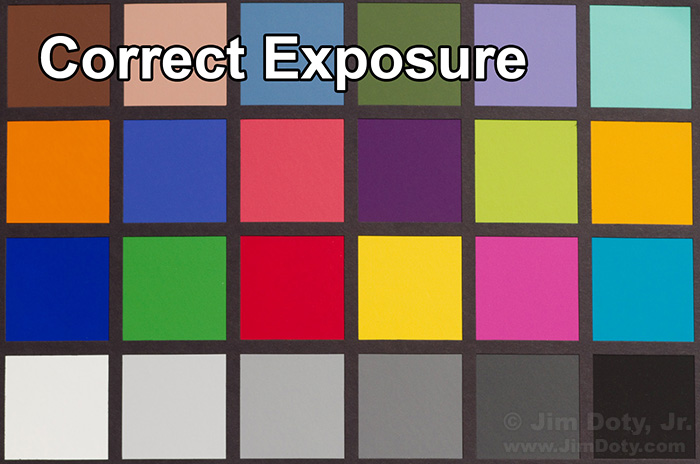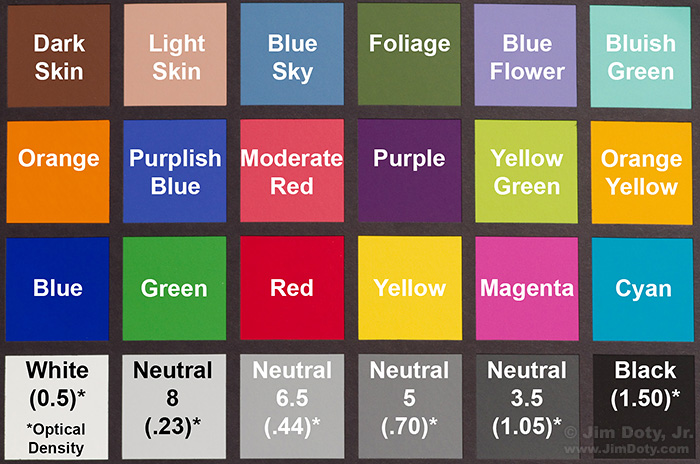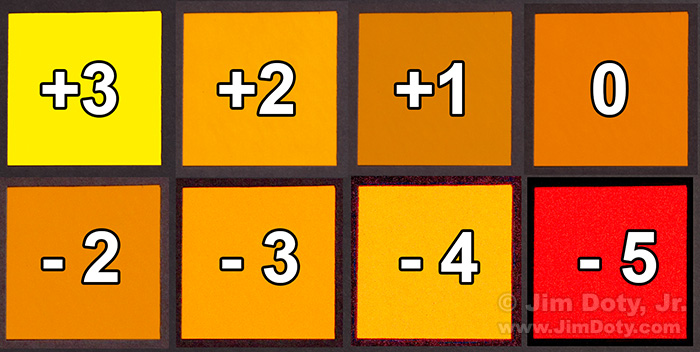When it comes to your digital camera, the better your metering skills, the better your colors will be. If you learn how to master exposure, you will get the best possible colors your camera is capable of producing. Why not put your camera on auto exposure and then correct the exposure on the computer? Because you won’t get the best colors. In auto exposure mode your camera is designed to give you average exposures, not the best exposures. This is very important: If you don’t nail the exposure in the camera, the colors in a photo will shift in different directions and no amount of computer work will bring them back. This is one of the best kept secrets of great color and it is why professional landscape, fashion, and advertising photographers are obsessive about exposure. There is no getting around mastering exposure if you want great color.
At the top of this article is a photo of a Gretag-Macbeth ColorChecker with all of the color patches labeled. I use a ColorChecker for several reasons. In this case I was checking the color response and color exposure latitude of a newly acquired digital camera body.
 In mid-day sunlight, I took a series of exposures beginning with the ideal, optimum exposure (as determined by both an incident light meter and an 18% gray card), and then I did a series of over and underexposures.The photo immediately above is the optimum, correct exposure for the ColorChecker.
In mid-day sunlight, I took a series of exposures beginning with the ideal, optimum exposure (as determined by both an incident light meter and an 18% gray card), and then I did a series of over and underexposures.The photo immediately above is the optimum, correct exposure for the ColorChecker.
The photo immediately above was over exposed in the camera and then the exposure was corrected in the computer using Adobe Camera Raw (ACR) which comes with Photoshop, Lightroom, and Photoshop Elements. Some of the colors are totally washed out and can’t be recovered. Other colors have shifted significantly. No amount of Photoshop work will bring these colors back.
 This photo above was under exposed in the camera and then the exposure was corrected in ACR. Some of the colors have gone almost black and others have shifted dramatically. No amount of work in Photoshop is going to save all these colors.
This photo above was under exposed in the camera and then the exposure was corrected in ACR. Some of the colors have gone almost black and others have shifted dramatically. No amount of work in Photoshop is going to save all these colors.
It will be easier to see the shift in the individual colors if we compare the colors in the chart row by row, starting with the top row.
Top Row of Colors:
 “Light Skin”, “Blue Flower”, and “Bluish Green” have lost their color in the overexposed photo. The delicacy of the colors is lost in the under exposed photo. If you were photographing a flower with petal gradations from bold to pastel, you would lose the wonderful and subtle range of colors in the flower petals. The “Dark Skin” is almost totally lost in the underexposed photo. The less accurate your exposure is (over or under), the more your skin tones will be off
“Light Skin”, “Blue Flower”, and “Bluish Green” have lost their color in the overexposed photo. The delicacy of the colors is lost in the under exposed photo. If you were photographing a flower with petal gradations from bold to pastel, you would lose the wonderful and subtle range of colors in the flower petals. The “Dark Skin” is almost totally lost in the underexposed photo. The less accurate your exposure is (over or under), the more your skin tones will be off
Second Row of Colors:
 “Orange”, has shifted to yellow in the over exposed photo and to red in the underexposed photo. Other colors have shifted. “Yellow Green” has lost all color in the over exposed photo, and purple is lost in inky darkness in the under exposed photo.
“Orange”, has shifted to yellow in the over exposed photo and to red in the underexposed photo. Other colors have shifted. “Yellow Green” has lost all color in the over exposed photo, and purple is lost in inky darkness in the under exposed photo.
Third Row of Colors:
These are the primary colors. “Red” has shifted to orange, “Green” has lost its purity, “Yellow” has lost all color, “Magenta” has shifted to pink, and the “Cyan” color is off in the overexposed photo. In the underexposed photo the colors have fared better, but they have lost their purity.
What does this mean in real world photography? The better your exposures are, the better your colors will be. If the metering is off, the colors will be off, and the worse the exposure gets, the worse the colors will get.
I picked obvious over and under exposed examples for the above photos so the color shifts would be obvious. But the color shifts are still there in less obvious examples. The farther you get from the ideal exposure, the greater the color shifts. If you over or under expose by too much, you are going to lose some colors and have other colors shift dramatically. No amount of work in Photoshop or other image editing software is going to restore those colors.
Let’s look at just one color from the Gretag-Macbeth ColorChecker.
After photographing the Color Checker with 8 different exposures, and then exposure correcting the images with ACR, I pulled out the orange color patch from all eight photos and put them together here. You can see how much the color of the orange patch has shifted. “0” is the ideal exposure and the best color. The farther away we get, the more the color shift. You could of course, color correct just the orange color patch, but the other colors would shift in the wrong direction and be even worse. The problem is, when colors shift due to an incorrect exposure, they shift in different directions. If you tryt to correct one color, the other colors get worse. The only solution to getting all the colors right is to nail the exposure in the first place.
So how much is too much under or over exposure?
That varies with every camera model. It also varies with whether you shoot RAW or JPEG files (RAW files give you more exposure color latitude). It also has a lot to do with your own individual tolerance for color shifts. And you have more latitude on the under exposure side.
The only way to know for sure is to test the “color exposure latitude” of your own camera. The color exposure latitude is how far over and under the ideal exposure you can be and still get great color. Next Monday’s article, How To Test Your Camera’s Color Exposure Latitude, will show you how.
Links
An introduction (with links at the bottom of the page) to the basics of exposure.
To learn how to get the ideal exposure in real world photography, read Digital Photography Exposure for Dummies. It has a 5 star rating at Amazon.com and it has one of the most comprehensive discussions of exposure of any book currently on the market. Learn more about the book here and order it at a discount at Amazon.com.
Order X-Rite’s Gretag-Macbeth ColorChecker in the Goodies Section (page 2) of my Photography Store which is powered by Amazon’s excellent prices, service, and guarantee.
The more adept you become at using ACR, the better your images will be. Read Mastering Photoshop & Lightroom: Adobe Camera Raw (ACR)




